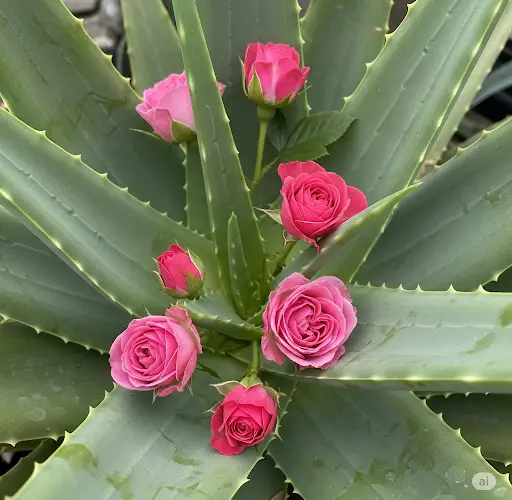Propagating roses from cuttings is a simple and cost-effective way to multiply your favorite rose varieties. While many gardeners rely on commercial rooting hormones, there’s a powerful and natural alternative that offers outstanding results—aloe vera. Known for its healing and nourishing properties, aloe vera is also an excellent tool for helping rose cuttings develop strong roots.
This method is completely organic, easy to follow, and ideal for beginners. Whether you’re trying to preserve a cherished rose variety or simply want to expand your garden, using aloe vera can significantly improve your success rate.
Why Use Aloe Vera to Root Rose Cuttings?
Aloe vera is a succulent plant that contains natural growth hormones, enzymes, and nutrients that aid in tissue repair and root formation. Its antibacterial, antifungal, and antioxidant properties help protect cuttings from infections, mold, and rot—common problems during propagation.
Benefits of using aloe vera for rooting rose cuttings include:
-
Promotes faster and stronger root development
-
Naturally protects cuttings from fungal and bacterial diseases
-
Moisturizes and nourishes plant tissue during the rooting phase
-
Safe, non-toxic, and chemical-free
These qualities make aloe vera a perfect natural substitute for synthetic rooting powders or gels.
What You’ll Need
To get started, gather the following:
-
A healthy, semi-hardwood rose stem (10–15 cm long)
-
A mature aloe vera leaf (or pure store-bought aloe vera gel)
-
A clean knife or pruning shears
-
Small pots or containers
-
Well-draining potting mix (mix of soil, sand, and perlite)
-
A plastic bag or clear bottle (to create a mini greenhouse)
Step-by-Step: How to Propagate Roses Using Aloe Vera
Step 1: Choose and Prepare the Cutting
Select a healthy stem from an existing rose plant. It should be semi-hardwood—neither too soft nor too woody. Cut a 10–15 cm section just below a leaf node. Remove flowers, buds, and the lower leaves, leaving a couple of leaves at the top.
Step 2: Extract Aloe Vera Gel
Cut an aloe vera leaf from the base of the plant. Slice it lengthwise to expose the gel inside. Scoop out the gel with a spoon or simply use the leaf as a rooting tube.
Step 3: Dip or Insert the Rose Cutting
Dip the cut end of the rose cutting into the aloe vera gel, coating it well. Alternatively, insert the cutting directly into a thick piece of the aloe leaf, allowing the stem to sit inside the gel-filled cavity.
Step 4: Prepare the Planting Medium
Fill a small pot with a well-draining soil mix. Make a small hole in the center, then gently place the cutting into the soil. Pat the soil lightly around the base to secure the cutting in place.
Step 5: Create a Mini Greenhouse
Cover the pot with a transparent plastic bag or a cut plastic bottle to create a humid environment. This helps retain moisture and warmth, both essential for root formation.
Step 6: Provide Ideal Conditions
Place the cutting in a spot with bright but indirect sunlight. Water lightly and keep the soil moist but not soggy. Too much water can cause the cutting to rot.
Step 7: Monitor Root Growth
After about 3 to 4 weeks, check for root development by gently pulling the cutting. If there’s resistance, roots have started to form. At this point, gradually remove the greenhouse cover to help the plant adapt to ambient conditions.
Extra Tips for Better Results
-
Sterilize tools before making cuts to prevent disease.
-
Avoid exposing the cutting to direct sunlight immediately after planting.
-
Use multiple cuttings to increase your chances of success.
-
Do not overwater—moisture is essential, but excess water can cause rot.
-
Combine aloe vera gel with cinnamon or honey for additional antifungal protection.
Best Time for Propagation
The ideal time to take rose cuttings is during late spring or early summer when the plant is actively growing. This ensures that the cutting has enough energy and favorable weather conditions to root successfully.
Which Roses Work Best?
Most types of garden roses, including hybrid teas, floribundas, and climbers, can be propagated using aloe vera. However, wild species or grafted varieties may not root as easily. Experiment with several stems to find what works best in your climate and soil type.
Final Thoughts
Using aloe vera to propagate rose cuttings is not only effective but also sustainable. It eliminates the need for synthetic chemicals and harnesses the power of nature to support healthy plant growth. With just a few materials and a bit of care, you can successfully grow new rose plants at home.
This natural method is a great option for gardeners looking to expand their rose collection, save money, and reduce their environmental impact. Try it yourself and experience the joy of growing roses from a single cutting—with the help of aloe vera.



